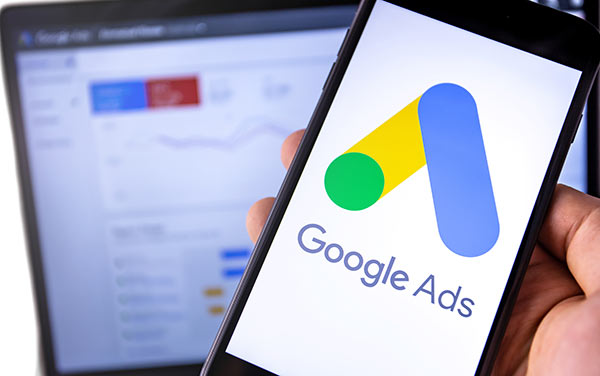Growing sales for your business is probably one of your top priorities. Everyone wants more leads, right? What if I told you there was a way to deliver a steady stream of pre-qualified customers to your business?
Customers that are actively searching for your products and services regardless of your industry and whether you were a business-to-consumer (b-to-c) or business-to-business (b-to-b) company. And these leads had a return on advertising spend of several hundred percent or more.
What I am referring to is Google Ads (formerly knows as Adwords) – also known as Google pay-per-click (PPC). Pre-qualified leads with a very high return on advertising spend – this is the value that Google Ads brings to your business. Google's system is what made Google what it is today. Google has become successful because it has been able to deliver so much value to its customers/advertisers.
The Google Ads platform is one of the most efficient and effective advertising options that every business should consider in their marketing toolkit.
In this post, my goal is to help you understand the basic concept of Google Ads and how it works. It is by far one of the most effective lead generation tools for any business.
Search and Display
Google Ads offers two primary ad platforms:
- Search
- Display.
I will be talking specifically about Search, not Display since search is the most efficient in terms of driving leads.
First, let’s make sure we are talking about the same thing throughout this post. Google Ads is also referred to as pay-per-click, or PPC, SEM (search engine marketing), or paid ads on Google.
Consumer Behavior and Google Ads
Let’s use a customer persona example to help frame our discussion about how Google Ads works.
Suburban Homeowner Example
We’ll use a persona named Jim.
Jim is a homeowner living in the suburbs with a 4-bedroom home. He is married and has two kids. Jim spends many weekends working on his yard and home maintaining it. One weekend Jim spends time putting in a new landscape in his front yard. After spending the weekend doing such physical labor, Jim’s exhausted and his body aches.
What is Jim, our homeowner, going to do? Jim knows that a massage could help him, and he wants to find a licensed massage therapist. So he grabs his phone, or goes to his desktop, and uses Google to search for “massage therapists near me.”
Micromoments
These decisions are what Google refers to as micro-moments. A point in time when a consumer needs information and turns to his smartphone to search for a solution. It is the shift to mobile that is making this even more important today. With smartphones, people have the ability to search for anything whenever they want or need.
So Jim is a pre-qualified lead. He is actively searching for a service in Google using keywords. Wouldn’t you want to capture that lead? Pre-qualified leads are one of the best scenarios a business owner can have because you know the customer needs your product or service!
Auto Accident Example
Sticking with our persona Jim, now imagine Jim is on his way to work and is rear-ended by another car. His car is damaged, and Jim ends up with a whiplash injury as a result.
Jim knows he is probably going to need a personal injury attorney and while on the side of the road he grabs his phone and pulls up Google and searches for the term “personal injury attorney.” That is another micro-moment.
The list of opportunities like this goes on and on.
Google is one of the first places consumers search for a product or service. According to Google, 82% of smartphone users use a search engine when looking for a business.
So How Does Google Ads Work?
When our persona Jim visits Google to search for anything in this micromoment, he is using keywords that he is typing into Google.
Google’s Ads (PPC) system works on keywords. You as a company can buy those keywords that Jim is typing and have a text ad appear at the top of Google’s search results. Text ads have a limit of two 30-character headlines, and one 80-character description line (this was recently updated by Google in July 2016 – the old format was one 25-character headline and two description lines with 35 characters each).
When someone clicks on that text ad, he or she is sent to a page on your website where he or she can find out more information about your product or service. As the example below illustrates for the query, “personal injury attorney San Diego.”
The first highlighted yellow circle is a different ad product - Local Service Ad (LSA). LSA ads are a very different product from Google Ads. LSA only show in certain industries, whereas Google Ads are not as restricted.
The second highlighted circle are Google Ads and what I'm talking about primarily in this post.
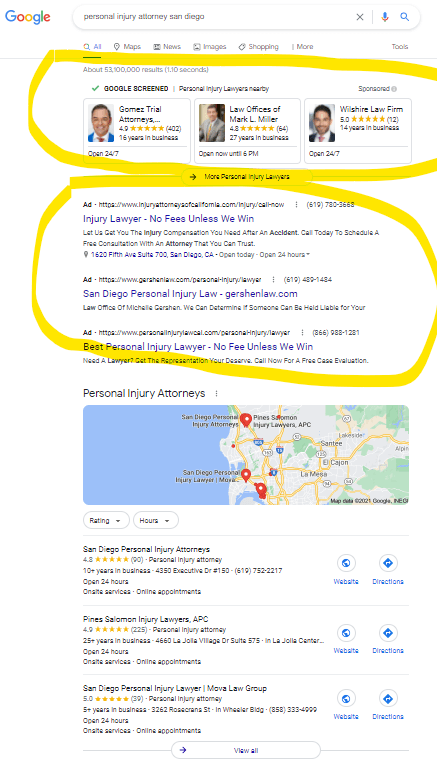
Google local search with LSA and Google Ads

Google local search with LSA and Google Ads
The area highlighted in yellow is where Google’s ads will show (and at the bottom of the page as well). Clicking on one of those ads will take you to that company’s website. The results outside of the highlighted yellow in the middle areas are NOT ads (i.e. below the map) – those are organic results and having your company appear there is a whole different discussion that revolves around traditional SEO and Google local SEO (related post here on what is local seo).
Paid Ads and Organic Results Are Not Related
Suffice it to say that organic results and paid results in Google are not related at all.
Just because you are running ads in Google does not mean you will have any better chance of having your company appear in the organic search results. Those two departments inside Google are completely separate, and the algorithms that run paid and organic are entirely different and independent.
Where Google’s Paid Ads Appear
Google will mix up the layout of these pages somewhat. Sometimes Google will not have any ads at the top and only have them at the bottom – this is because it doesn’t want consumers to get used to seeing ads at the top and thus become conditioned to them and skip over them. This strategy helps with CTR (click-through-rate) on ads for its advertisers.
In our prior examples, all the leads from those keyword phrases were pre-qualified. People actively typed in a search query using keywords looking for a product or service.
Bidding System
The Google Ads platform is a real-time bidding system. So you as an advertiser tell Google what you are willing to pay or willing to bid for a keyword along with other advertisers that are also bidding on those keywords.
The price you pay for a keyword is mainly based on how many other advertisers there are bidding on the same keyword and the price the other advertisers are willing to bid. The price per keyword can be pushed up as more advertisers compete for keywords.
For example, if there are 10 advertisers, and they are all bidding somewhere between $2 – $6 for a keyword and you bid $6.50, all things being equal, your ad will appear at the top of the page ahead of theirs (this is an over-simplistic explanation, but it basically works like that).
Google Ads Algorithm Ensures Quality
Google has a very sophisticated system. Just because you have the money does not mean you can beat your competitors with large budgets and high bids and appear on the top of the page.
Part of the Google Ads algorithm that ensures quality is Ad Rank – your ad rank is made up of your bid (i.e. how much you’re willing to pay per keyword), quality of your ads, and your landing page (related post on how to maximize your conversions with landing page and Google Ads alignment).
With lower ad rank scores, you will pay more for your keywords (sometimes you can pay 3 times or more than a high-quality advertiser), or worse yet your ads may not even show.
So while Ads is a pay-to-play platform, if you write poor ads that nobody is clicking on, and the user experience on your site is poor, Google will punish you as an advertiser by charging you more – in essence, the system will reward quality advertisers with lower costs.
Dentist Example
Google Ads also provides tools, so you can find out all sorts of information about a particular keyword, such as estimated bid price, volume, competitiveness, and more.
In keeping with our persona Jim, let’s say Jim needs a dentist for one of his kids. Jim searches for “children’s dentist near me.”
Google Ads Keyword Planner Tool
Google Ads will show us a range of keyword options with estimated monthly search volumes, level of competition, and its suggested bid.
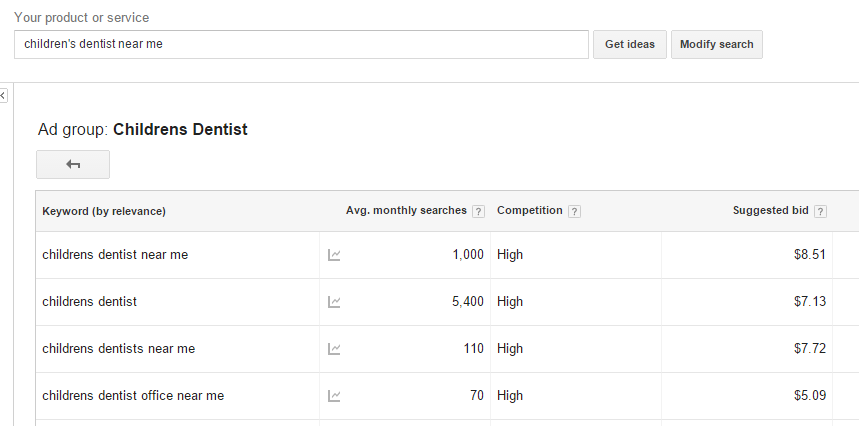
Google Keyword Tool Dentist Search Volumes

Google Keyword Tool Dentist Search Volumes
In this example of a dental query, we can clearly see “children’s dentist near me” has 1,000 monthly queries, and “children’s dentist” has 5,400 monthly searches. The suggested bid is $8.51 and $7.13 respectively.
Now dentistry is a very competitive space, so the cost-per-click (CPC) is much higher than other industries (more here on Internet marketing for dentists).
Don’t be put off if a keyword is a higher price than you expected – higher prices often mean there’s real economic value there or others would be unwilling to pay for it.
In many retail brick-and-mortar businesses, the CPC can be between $1 – $3. Your mileage will vary, and you just need to do some keyword research to understand what your costs might be.
Get Specific With Geographic Targeting
The other component of Ads is the geo-targeting. We’ve talked about buying keywords to have your ads appear, but where are these ads going to show geographically?
Do you want your ads to show all over the U.S.? Or just in your small town? Or do you prefer to have your ads appear only within 3 miles of your business address? Alternatively, perhaps you want your ads to show only in certain zip codes. All these targeting options are possible.
Ads allows you to be very specific geographically by offering numerous ways to target your potential customers. The smallest geo-target you can set is a 1 km radius around a point.
For you to be effective, you do not want to show your ads outside of where your customers are or are willing to travel to visit you.
Geo-targeting examples
Targeting an entire county – in this case, it is San Diego County.
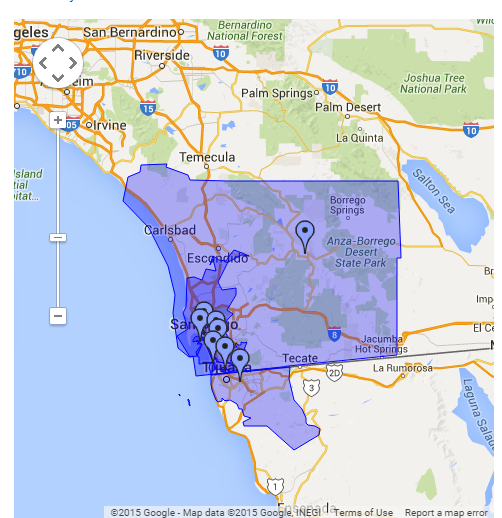
Google Ads Geo Targeting A County

Google Ads Geo Targeting A County
Here’s an example of geo-targeting around a particular point on a map using a radius of 5 miles.
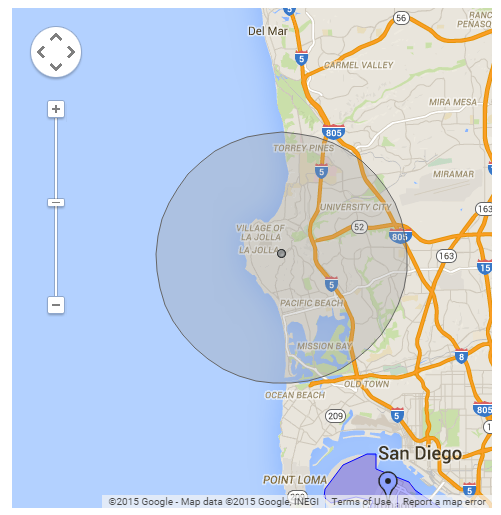
Google Ads Radius Targeting Example

Google Ads Radius Targeting Example
Here’s an example of how you can target specific zip codes – in this case, I chose the 92127 zip code in San Diego.
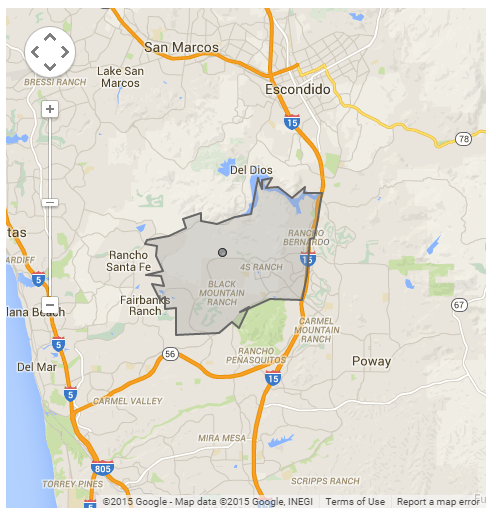
Google Ads Geo Targeting by Zip Code

Google Ads Geo Targeting by Zip Code
So the options are many, and you can be very specific with your geographic targeting.
How Does Geo-Targeting Work?
If you’re on a desktop, Google knows where you are based on your IP address. And if you’re on a cell phone it knows based on your device’s location through GPS, or cell phone data. It shows ads based on this location information.
However, Google will also show your ads to people outside of the geo areas if the intent is clear they are looking for a product or service in your targeted geo area.
For example, if I’m on a trip to the east coast but I need a dentist in San Diego and I type into Google, “dentist San Diego,” Google may show an ad to me from a dentist in San Diego in spite of the fact that I’m on the east coast. This makes sense though – the intent is clear that I want a dentist in San Diego so it is showing the ad to me.
Do Google Ads Work For All Businesses?
I’ve been using Google Ads since 2007 with hundreds of different businesses and industries. I’ve run across very few businesses where it does not work.
I’ve seen Ads work well for professional service industries, startups, retail, software, product-oriented companies, b-to-b, b-to-c, restaurants, hospitality, brain surgery – you name the industry, and it will probably work.
Nonetheless, there have been cases when the competition has been so competitive that the CPC (cost-per-click) was so high that it did not make financial sense to bid on keywords. The cost to acquire a customer was too high. Mostly I see this in e-commerce transactions where companies are selling a product.
Does Ads Work For Any Business?
However, even in cases where it is highly competitive, many times it still makes sense to run an Ads campaign. In highly competitive spaces online, this decision depends largely on your business model. Some companies can afford to acquire a customer for no profit or even a loss if the lifetime value of the customer exceeds the initial cost to acquire the customer. This is something you will have to decide as you move forward, but just remember to think about the business model and the lifetime value of a customer – what is the real value behind a customer, not just the initial transaction you earn from him.
Click the link here for a related post on identifying how much you should I spend on Google Ads.
I hope this was helpful – I appreciate any comments below, and it helps the overall community.

